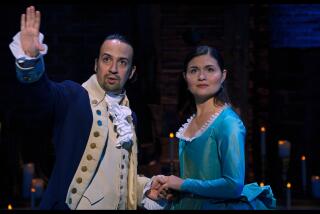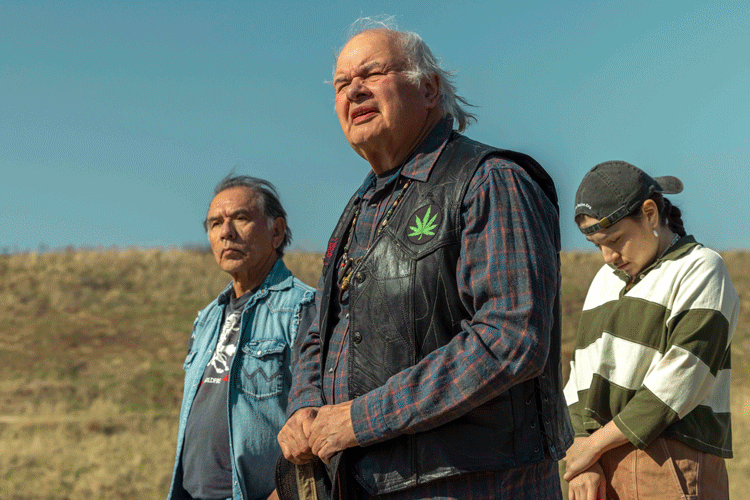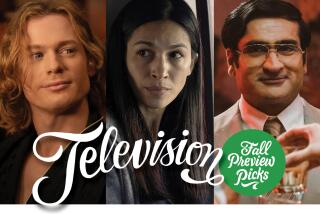TV Picks: ‘What Not To Wear,’ ‘Breaking Bad ‘ Larry David twice
“What Not To Wear” (TLC, Fridays). One of the greatest series on television begins its final season this week. I speak of course of the decade-old “What Not To Wear,” based on an earlier British model, in which friendly yet acerbic, gentle but firm hosts Stacy London and Clinton Kelly help the sartorially challenged see themselves as they are and as they could be, and should be. The best of all makeover shows because it’s the least judgmental on one hand and the least sentimental on the other, it is not immune to passages of artificially heightened drama -- variations on “She’ll never cooperate!” from the hosts’ side and “I’ll never cooperate!” from the guest’s. And yet it is also authentically, deeply and reliably moving: Each episode begins with an intervention and ends as a celebration, as caterpillars become butterflies and cygnets the swans they always were, beneath shapeless sweatshirts or age-inappropriate hot pants. By freeing their subjects from bad habits of dressing, through such cruel-to-be-kind devices as the 360-degree mirror and helpful discussion of silhouettes and such, London and Kelly also help them toward more basic sorts of self-knowledge. Although both hosts have the sort of bodies that clothes line up to be worn by, they have no prejudice about yours; they only want you to love it for what it is and dress it better: “The clothes are symbolic, in the sense that it is about taking control of one’s image, and when a lot of these contributors leave the show, they take control of other aspects of their life,” London told me in 2010. “The minute you can get over the idea that you are going to dress in a way that makes you look like another person and accept the person that you are, then you become your own frame of reference and standard of beauty, and that’s when you start to get great personal style.” There will be tears, and some of them will be mine.
PHOTOS: Hollywood Backlot moments
“Breaking Bad” (AMC, Sunday); “Breaking Bad: The Middle School Musical” (rhettandlink.com). Another show begins its last run of episodes this week. “Breaking Bad” has been called the best show on television so often that it has almost become part of the title, the way the Rolling Stones have all but trademarked “World’s Greatest Rock & Roll Band”; it is reflexively accepted, like sunlight or gravity. I’ve blown hot and cold on the series over its run, or more precisely, I’ve had troubles with Walter White (Bryan Cranston), who grew less interesting to me the farther he traveled into the darkness and the more he fancied himself a tough guy. It’s a character steeped in self-pity and tiresome over the long haul; lately I’ve admired the artistry (which is considerable, on every level) more than I’ve liked the story. At the same time, I have watched every episode so far and I will watch every one until the end. That it will end, I take as something of a relief, whatever does or doesn’t become of Walt. (Indeed, he’s the character whose fate least worries me -- I’m still invested in Jesse and Skyler and Hank.) Will he get his comeuppance? Audiences do hate ambiguity, but life likes it. There is a reason David Chase cut to black before whatever happened to Tony Soprano happened to Tony Soprano. As in the first half of this final season, the first episode of the second half (directed by Cranston) opens with a tantalizing flash forward.
Meanwhile, in “Breaking Bad: The Middle School Musical,” Rhett McLaughhlin and Charles Lincoln Neal, the stars of IFC’s “Rhett & Link: Commercial Kings” and authors of many online musical acts of japery, have compressed the series’ run (with a proposed ending) into just under six minutes, with pitch-perfect sets and songs, each of which makes a complex impression in a very short time, and a talented and enthusiastic adolescent cast. Walt: “I’m going to use my science knowledge to make the purest rock candy this town has ever scene.” Jesse: “Yo, Mr. White, it’s me, your former student, Jesse. I hear you’re breaking bad now.” It’s a weirdly charming, almost lovely, very funny, oddly uplifting thing. There’s a winsome song for the rock candy to sing (“I’m blue rock candy/Here to make you smile”) and a Latin number for Gustavo Fring (“Are you chickens like the chickens in my chicken restaurant?”), featuring dancing poultry. At the end, “Everyone’s sad/But we won five Emmys/Rad!/We’re ‘Breaking Bad!’”
PHOTOS: Celebrities by The Times
“Clear History” (HBO, Saturday); “The Best of ‘Fridays’ ” (Shout Factory DVD). Larry David, who is on a break from “Curb Your Enthusiasm” -- permanent or not, he’ll let you know -- returns to HBO on Saturday with a full-on movie-type movie in which he plays not his fictionalized self but an entirely different character that shares all the same tics, obsessions and self-obsession. (At the beginning, with long hair and a long beard, he looks like “Curb” director and “Seinfeld” writer Larry Charles, but eventually he gets to looking like his familiar old self.) Here David plays Nathan Flomm, a Clio-winning marketing exec who, like the David of “Curb,” is undone by his inability to concede a point, giving back his share in an electric car company over protest that its CEO (Jon Hamm) wants to name a new model after his son, who is named after the hero of “The Fountainhead.” “Nobody’s going to buy a car named Howard; it’s like calling a restaurant Hepatitits.” The car is an enormous success, losing Nathan a billion dollars and making him a national laughingstock. We meet him again years later on Martha’s Vineyard, living modestly and happily under an assumed name, looking not like Larry Charles but Larry David, amid a cast that includes Danny McBride, “Curb” foil J.B. Smoove, Philip Baker Hall, Michael Keaton, Eva Mendes, Amy Ryan, Bill Hader and Liev Schreiber. When Hamm’s character coincidentally arrives, the bad feelings flood back and a revenge plot is set in motion.
Long before “Seinfeld” changed everything, David, with the future Cosmo Kramer, Michael Richards, was a member of the cast of “Fridays,” a selection of whose episodes has just been released (with extras) in a box set from Shout Factory. Airing late-night from 1980 to 1982, it was ABC’s somewhat belated answer to “Saturday Night Live,” down to the makeup of the cast -- four men (one black) and three women -- and the news segment in the middle. (The cast also included Bruce Mahler, who would play Rabbi Glickman on “Seinfeld”, echoing a recurring bit he did with David here; Larry Charles was a staff writer.) It’s not a great show, but it is an ambitious one, with a bent for postmodern self-reflection and meta-fun. Some of its concepts and strategies are Avant-Garde Theater 101, and they broke the fourth wall on “SNL,” too, but “Fridays” made a real, repeated point of it. One episode was conceived as the 1980 Republican National Convention, with the audience as conventioneers. In one sketch, a couple shows off their new apartment, which comes with its own studio audience. In another, Melanie Chartoff plays a little girl who learns that not only is the tooth fairy not real, but that her parents are actors, her room is a set, and that she herself is an actress -- and, in a short nightgown, an exploited one at that, because “showing sex-related material such as the smooth skin of your thigh keeps people watching,” upon which the sketch becomes a self-reflexive disquisition upon television. (“There are some good programs, but most of them are superficial. On the other hand, there are things that about this sketch that are kind of pretentious.”) William Shatner appears as Capt. Kirk transported back to the 1980s and mistaken for William Shatner. (He’s also very funny as a sleep-deprived air-traffic controller -- read your history.) The set includes a famous episode hosted by Andy Kaufman (recreated for “Man on the Moon”), an “experimental” prank in which Kaufman seemed to hijack the show, bailed out of sketches and broke up constantly. It was continued the following week, when he returned to read an apparently coerced false apology, which was also part of the plan.
More to Read
The complete guide to home viewing
Get Screen Gab for everything about the TV shows and streaming movies everyone’s talking about.
You may occasionally receive promotional content from the Los Angeles Times.







